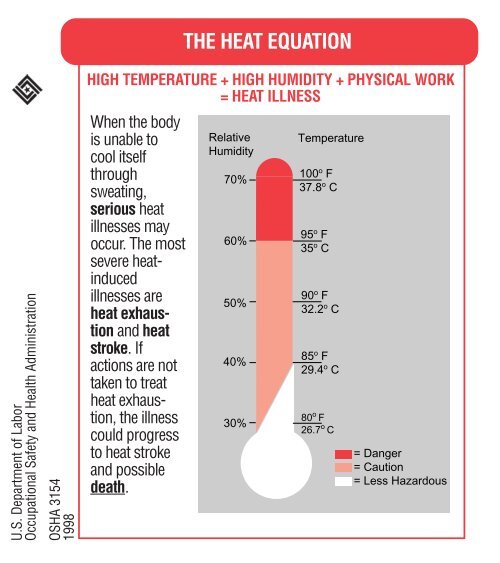6722 HEAT STRESS CARD
6722 HEAT STRESS CARD
6722 HEAT STRESS CARD
You also want an ePaper? Increase the reach of your titles
YUMPU automatically turns print PDFs into web optimized ePapers that Google loves.
U.S. Department of Labor<br />
Occupational Safety and Health Administration<br />
OSHA 3154<br />
1998<br />
THE <strong>HEAT</strong> EQUATION<br />
HIGH TEMPERATURE + HIGH HUMIDITY + PHYSICAL WORK<br />
= <strong>HEAT</strong> ILLNESS<br />
When the body<br />
is unable to<br />
cool itself<br />
through<br />
sweating,<br />
serious heat<br />
illnesses may<br />
occur. The most<br />
severe heatinduced<br />
illnesses are<br />
heat exhaustion<br />
and heat<br />
stroke. If<br />
actions are not<br />
taken to treat<br />
heat exhaustion,<br />
the illness<br />
could progress<br />
to heat stroke<br />
and possible<br />
death.<br />
Relative<br />
Humidity<br />
70%<br />
60%<br />
50%<br />
40%<br />
30%<br />
Temperature<br />
100 o F<br />
37.8 o C<br />
95 o F<br />
35 o C<br />
90 o F<br />
32.2 o C<br />
85 o F<br />
29.4 o C<br />
80 o F<br />
26.7 o C<br />
= Danger<br />
= Caution<br />
= Less Hazardous
<strong>HEAT</strong> EXHAUSTION<br />
What Happens to the Body:<br />
HEADACHES, DIZZINESS/LIGHT HEADEDNESS, WEAKNESS,<br />
MOOD CHANGES (irritable, or confused/can’t think straight),<br />
FEELING SICK TO YOUR STOMACH, VOMITING/THROWING UP,<br />
DECREASED and DARK COLORED URINE, FAINTING/PASSING<br />
OUT, and PALE CLAMMY SKIN.<br />
What Should Be Done:<br />
• Move the person to a cool shaded area to rest. Don’t leave the<br />
person alone. If the person is dizzy or light headed, lay them on<br />
their back and raise their legs about 6-8 inches. If the person is<br />
sick to their stomach lay them on their side.<br />
• Loosen and remove any heavy clothing.<br />
• Have the person drink some cool water (a small cup every 15<br />
minutes) if they are not feeling sick to their stomach.<br />
• Try to cool the person by fanning them. Cool the skin with a<br />
cool spray mist of water or wet cloth.<br />
• If the person does not feel better in a few minutes call for<br />
emergency help (Ambulance or Call 911).<br />
(If heat exhaustion is not treated, the illness may advance to<br />
heat stroke.)
<strong>HEAT</strong> STROKE—A MEDICAL EMERGENCY<br />
What Happens to the Body:<br />
DRY PALE SKIN (no sweating), HOT RED SKIN (looks like a<br />
sunburn), MOOD CHANGES (irritable, confused/not making any<br />
sense), SEIZURES/FITS, and COLLAPSE/PASSED OUT (will not<br />
respond).<br />
What Should Be Done:<br />
• Call for emergency help (Ambulance or Call 911).<br />
• Move the person to a cool shaded area. Don’t leave the<br />
person alone. Lay them on their back and if the person is<br />
having seizures/fits remove any objects close to them so<br />
they won’t strike against them. If the person is sick to their<br />
stomach lay them on their side.<br />
• Remove any heavy and outer clothing.<br />
• Have the person drink some cool water (a small cup every<br />
15 minutes) if they are alert enough to drink anything and<br />
not feeling sick to their stomach.<br />
• Try to cool the person by fanning them. Cool the skin with a<br />
cool spray mist of water, wet cloth, or wet sheet.<br />
• If ice is available, place ice packs under the arm pits and<br />
groin area.
How to Protect Workers<br />
• Learn the signs and symptoms of heat-induced illnesses and<br />
what to do to help the worker.<br />
• Train the workforce about heat-induced illnesses.<br />
• Perform the heaviest work in the coolest part of the day.<br />
• Slowly build up tolerance to the heat and the work activity<br />
(usually takes up to 2 weeks).<br />
• Use the buddy system (work in pairs).<br />
• Drink plenty of cool water (one small cup every 15-20<br />
minutes)<br />
• Wear light, loose-fitting, breathable (like cotton) clothing.<br />
•. Take frequent short breaks in cool shaded areas (allow your<br />
body to cool down).<br />
• Avoid eating large meals before working in hot environments.<br />
• Avoid caffeine and alcoholic beverages (these beverages make<br />
the body lose water and increase the risk for heat illnesses).<br />
Workers Are at Increased Risk When<br />
• They take certain medication (check with your doctor, nurse, or<br />
pharmacy and ask if any medicines you are taking affect you<br />
when working in hot environments).<br />
• They have had a heat-induced illness in the past.<br />
• They wear personal protective equipment (like respirators or suits).
















